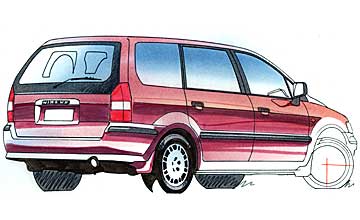BY MALCOLM LIVERMORE | 22nd Feb 2001

Originally shown as the Chariot concept car at the 1979 Tokyo Motor Show, the Nimbus went into production four years later.
Based on the front-wheel drive Colt that was a Mitsubishi mainstay throughout the 1980s, the Nimbus arrived in Australia in 1984 to immediate fanfare, winning a car of the year award.
Since then the Nimbus has grown in size and refinement, first as the UF series of 1992 and again in late 1998 with the introduction of the current UG model.
Today's Nimbus is all-new, save for the carry-over 2.4-litre engine which is also used in the Starwagon and the recently discontinued four-cylinder Magna.
Mitsubishi took a clean sheet approach to the Nimbus' design and execution.
It is a more stylish and accommodating people-mover.
The Nimbus is appreciably bigger in every direction - inside and out - compared to the previous model, which explains why there is a significant price increase.
Still, the seven-seater Mitsubishi costs less than the Honda Odyssey yet virtually matches it for size, features and performance.
More sound deadening and a stiffer body mean the torquey 96kW, 2.4-litre, four-cylinder engine is quieter and smoother than before.
It is reasonably gutsy, too, adequately hauling seven 70kg adults with the air-conditioning on.
Only overtaking manoeuvres and big hills show up the Nimbus' capacity and cylinder deficit compared to, say, a Mazda MPV or Chrysler Voyager.
Nevertheless, at all times the Mitsubishi's credible on-road behaviour tends towards being more like a car than a people-mover.
The car-like perimeter frame body is the reason, offering improved safety, refinement and dynamics compared to the previous model.
The handling really is nimble and fun.
There is some body roll but the ride and roadholding are perfectly acceptable and the power-assisted steering feels direct and communicative.
The shift lever, mounted in a truncated console in the centre of the dash, is easy to use and well placed for convenience, so cog swapping is not a chore.
And the automatic, which sits in the same position, is much easier to use than, say that on a Honda Odyssey with its column-shift arrangement.
Standard features in the Nimbus include a driver airbag, air-conditioning, remote central locking, a four-speaker radio/cassette, power steering, power windows, power mirrors and a trip computer.
Versatility is Nimbus' calling card. It features "walk-through" front to middle seating, removable rearmost seats, an impressive range of seating/sleeping/ cargo configurations - made possible by folding, reclining, sliding and/or removing seats - and the expected multitude of storage areas and cupholders.
Options include a package that incorporates passenger-side airbag and anti-lock brakes.
Seven adults can be seated in comfort. The driver enjoys panoramic views, the ergonomic dashboard is attractive while the tough yet plush fabrics feel comfortable and durable.
Their slightly psychedelic pattern affect could look like an acid flashback to many of the former hippie parents who would make up a fair percentage of the buyer profile.
The latest Nimbus is a clever and capable people-mover with a price advantage over its rivals that cannot be ignored.
It also reflects the many years of experience the Japanese company has accumulated in building vehicles of this type.
- Automotive NetWorks, 05/07/1999